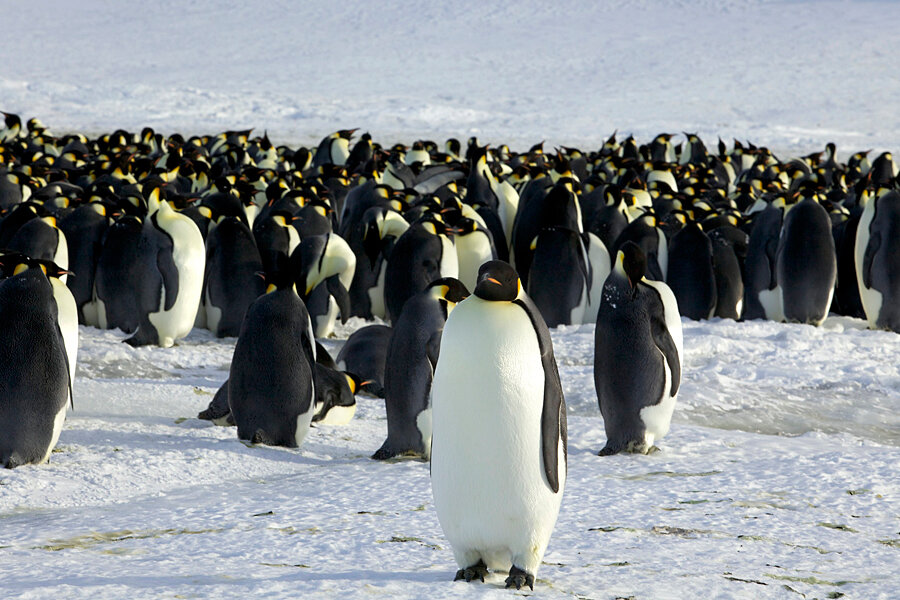Antarctica warming tied to natural cycle in tropical Atlantic, study says
Loading...
Rapid warming along the Antarctic Peninsula and puzzling shifts in the distribution and extent of winter sea ice at the bottom of the world appear to have their roots in a natural climate swing centered in the tropical Atlantic, according to a new study by researchers at New York University.
The warming of the region is of concern because of its implications for sea-level rise, while the shifting and slight increase in winter sea ice has become a favorite talking-point among many of global warming’s political skeptics.
The climate swing the researchers discussed, known as the Atlantic Multidecadal Oscillation (AMO), shows up as a cycle of warmer, then colder-than-normal sea-surface temperatures. The cycle repeats itself once every 40 to 80 years or so, with cooler or warmer temperatures lasting for periods of 20 to 40 years or more. Since the mid-1990s, the AMO has been in a warm phase.
If the results hold up to additional scrutiny, they would suggest that the initial trigger for the rapid warm-up of the Antarctic Peninsula and a key driver behind its intensification to date is natural variability, in addition to any influence from global warming.
Over the past 50 years, the region's average winter temperature has risen by 5.6 degrees Celsius (10 degrees Fahrenheit). Untangling the relative influence of natural climate swings and warming from the build-up of greenhouses gases from human industrial activities and land-use changes has been challenging in this region. Climate models have generally failed to reproduce the warming on the peninsula, according to researchers with the British Antarctic Survey. This makes it hard to say if the region's rapid warming will continue.
Getting a better handle on the drivers behind the warming is crucial to projecting the future of the region and its glaciers, rivers of ice whose loss currently is contributing to sea-level rise.
Counterintuitively, the mechanism that the study’s lead author Xichen Li and colleagues at NYU have identified also suggests that as the climate continues to warm, its effect on AMO may lead to a continued long-term growth in the extent of winter sea ice off of Antarctica.
The results came as a surprise to the research team, says David Holland, a researcher at NYU’s Center for Atmosphere and Ocean Science who studies climate change and the interaction between ice and oceans.
The team initially focused its attention on global warming's effect on Greenland's ice sheet, he explains. While the AMO displays its strongest effect on sea-surface temperatures in the tropical Atlantic, it also has a similar, though weaker effect on the North Atlantic.
The team analyzed more than 30 years' worth of temperature data for Greenland, and detected an effect, prompting them to ask if any other region of the world was influenced in the same way.
"All we could find was a relation between the North Atlantic and the South Pacific sector of Antarctica," Dr. Holland says. The team then turned to an atmospheric model to see if the relationship showed up there as well. It did.
Essentially sea-surface temperatures during the AMO's warm phase form atmospheric waves that quickly end up in Antarctica's South Pacific sector, triggering the formation of a patch of low pressure about the size of the continental US. This region of persistent low pressure sets up over the Amundsen Sea west of the Antarctic Peninsula.
In the Southern Hemisphere, winds in a low-pressure system flow clockwise. This circulation draws warm marine air from the northwest and onto the peninsula. As the flow continues, it moves across the ice sheet and back out to sea, driving winter sea ice from the Bellinghausen and Amundsen Seas into the ice that has formed on the Ross Sea and reducing concentrations in the Weddell Sea as well.
A formal report of the results appears as a paper in the current issue of the journal Nature.
In the end, other factors are likely to be supporting the growth of winter sea ice off of Antarctica, researchers say. For instance, some researchers have shown how an increase in meltwater from thinning ice shelves in West Antarctica may be freshening seawater, raising its freezing point. This fresher water would freeze more readily than its saltier counterparts.
"There probably are multiple causes" for the slight increase in winter sea ice detected so far, writes John King, science leader at the British Antarctic Survey in Britain in an e-mail.
"I think Li and co-authors make a pretty strong case for the Atlantic being potentially important," he writes. "Their paper is a useful step forward in understanding recent Antarctic climate change, but it's not the end of the story."





